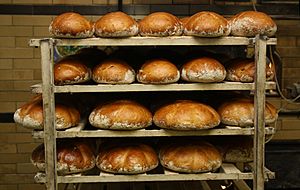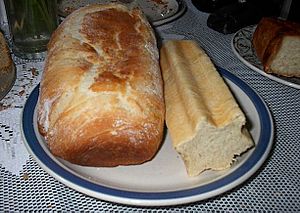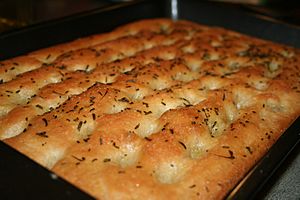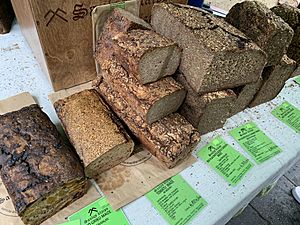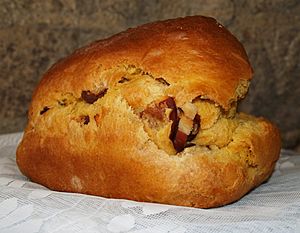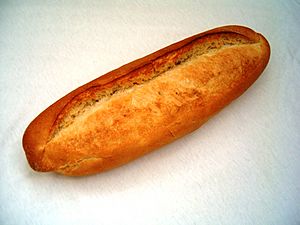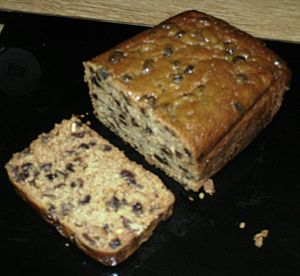Bread in Europe facts for kids
Bread is a super important food all over Europe. For hundreds of years, people have eaten bread every day. In the 1900s, people started making a lot more bread around the world. This happened because more land in Europe, North America, and Africa was used to grow crops for bread.
Contents
Bread in Different European Countries
Czech Republic
In the Czech Republic, they make many kinds of bread. Most of it is sourdough bread, which means it uses a special starter to rise. The type of flour used changes how the bread tastes. Loaves sold in stores are usually not wrapped. But if a loaf is cut in half, shops must wrap it in plastic. There's also a special bread called toustový chléb (toast bread), which is only used for making toast.
Denmark
In the late 1800s, bakers in Danish towns started making fresh bread every morning. This bread, called morgenbrød, was mostly made from wheat. It came in many shapes and had different flavors. It was popular with richer families. Today, you can still find this fresh bread in every Danish bakery. People in Denmark used to eat a lot of rye bread, but now they eat more wheat bread.
France
In France, a type of bread called pain de mie is used for toast or for making stuffing (a mix of ingredients used to fill other foods). Regular French bread, like baguettes, has a thick, crunchy crust and often has big air bubbles inside. Bakers often bake it three times a day, and it's sold without wrapping to keep the crust crisp. Some special breads have walnuts or are covered with poppy seeds.
Germany
Germany is famous for having the biggest variety of breads in the world! They make over 300 basic kinds of bread, plus more than 1,000 types of small bread rolls and pastries. It's thought that over 1,000 different breads were shown at a bread fair in Cologne in 2005. Germans eat more bread per person than anyone else in the world, followed by Chile. In 2012, there were 13,666 bakeries in Germany, but this number is slowly going down as more people buy bread from supermarkets.
Finland and Russia
Finland and Russia both have dark sourdough breads made from rye. Traditional Finnish rye bread is round with a hole in the middle, which made it easier to store. These breads are rougher and have a stronger taste than wheat bread. They can also be stored for a long time. Some families even pass down their special sourdough starters from one generation to the next!
Bread in Finland is made from wheat, rye, barley, and oats. Rye bread can be light or dark, depending on the flour mix. There are also thin, multigrain breads. Vesirinkeli (water rings) are small, plain wheat bread rings that look a bit like bagels. Potatoes, which came to Finland later, are now used in many kinds of Finnish bread.
Iceland
When people first settled in Iceland around 800-900 AD, they brought barley with them to make bread and porridge. Growing grain became difficult before 1600 because the weather got colder. After that, most grains like barley and rye had to be brought in from other countries.
To make their grain last longer, people in some areas used seaweeds like dulse or Iceland moss in their breads. It wasn't until the 1700s that making leavened rye breads became common, mostly using sourdough. Today, rye breads baked in hot springs are very popular with both locals and tourists!
Instead of bread, people in Iceland often ate stock fish (dried fish) with butter. It was served with almost every meal. Now, stock fish is a popular snack, especially for athletes, because it's full of protein. Most types of bread found in other Western countries are now available in Iceland too. Flatbrauð (flatbread) and laufabrauð (leaf bread) are two of Iceland's oldest bread types. Iceland's first bakery, Bernöftsbakari, opened on September 25, 1834.
Italy
Italy has a long history of different regions, and because of this, it has many different kinds of bread. Each region has its own special recipes and traditions. Generally, smaller bread rolls are popular in the northern parts of Italy, while large loaves are common in the south. Italian bread often has a little olive oil, butter, or lard mixed into the dough to make it softer.
Traditional country breads include sfilatino imbottito (a stuffed bread roll) and pizza bianca (a flat white bread). Focaccia is very popular in Italy and southern France. It's usually flavored with olive oil and herbs, and sometimes topped with cheese or stuffed with meat or vegetables. Focaccia dough is similar to pizza dough.
Ireland
In Ireland, many people believe the "heel" (the end piece) of a loaf of bread is the best part! There are even old stories and myths about it. Irish soda bread is special because it's a quick bread. This means it uses buttermilk and baking soda to rise, instead of yeast. This type of bread was created to make the most of the soft wheat grown in Ireland.
Another traditional Irish bread is barmbrack, which is a yeast bread with sultanas and raisins. It's usually eaten at Halloween. Potato bread is also a traditional Irish bread, especially in a part of Ireland called Ulster.
Latvia
In Latvia, rye bread (rudzu maize) has been a very important food for hundreds of years. It's even part of the Latvian Culture Canon (a list of important cultural things). This bread is similar to a dark bread from Russia or Germany. It's made from coarse rye flour, malt, and caraway seeds, and traditionally baked in a wood-fired oven. Leftover rye bread is used to make a dessert called rupjmaizes kārtojums.
Another popular bread is sweet and sour bread (saldskābmaize), made from finely ground rye flour and caraway seeds. Fried rye bread with garlic (ķiploku grauzdiņi) and mayonnaise is often served as a starter in restaurants. White bread (baltmaize) used to be a special treat, only eaten on holidays.
Norway
Many new kinds of bread have become popular in Norway recently. People now eat more types like spelt, specialty, gourmet, and fiber breads, as well as ciabattas and baguettes. Norwegian bakers now compete with breads brought in from other countries, which are often cheaper. Flatbread is still a very popular type of bread in Norway.
Portugal
Broa de Avintes is a traditional farmhouse bread from a place called Avintes. It's very popular in the northern part of Portugal. Folar is a special Portuguese bread eaten at Easter. The recipe changes from region to region, and it can be sweet or savory. Portuguese sweet bread is made with milk, sugar or honey, eggs, yeast, and flour. Sometimes lemon peel is added. It makes a slightly sweet, soft loaf or rolls.
Spain
In Spain, traditional bread, or pan, is a long loaf. It's like a French baguette but wider and shorter. It's often called "barra" or other names like "pistola" or "bastón". There are also many other types of bread with different shapes and recipes, such as "chapata", "payés", "gallego", and "mollete". French baguettes are also common in bakeries.
You can buy fresh bread every morning in almost every supermarket or traditional bakery. Bread is eaten with almost every meal in Spain. It's also a key part of famous Spanish foods like bocadillos (sandwiches) and pinchos (small snacks). In Spain, especially near the Mediterranean Sea, there have been groups of bakers for over 750 years! The bakers' group in Barcelona started in 1200 AD. There's even a region called Tierra del Pan ("Land of the Bread") where making bread was once the main way people earned a living.
Sweden
In Sweden, during the 1800s, when cities and factories grew, bread types changed. Big bakeries started making new, soft breads. From the early 1920s, these breads were often sweetened. People started buying bread from stores instead of baking it at home. Because bread was transported and sold everywhere, the differences in bread types between regions became smaller. Since the 1990s, people in Sweden have been eating more bread. Wholegrain bread and wheat bread are the most popular. Many older types of bread still exist alongside the newer ones.
Turkey
Bread is a very important part of Turkish food and is eaten often. According to the Guinness World Records in 2000, Turkey eats the most bread per person in the world! Each person ate about 199.6 kilograms (440 pounds) of bread that year. Serbia and Montenegro were next, followed by Bulgaria.
Besides the common bread shown in the picture, other popular types include bazlama, gözleme, lavaş, pide, simit, and yufka. A special type of pide bread, called Ramazan pidesi, is traditionally eaten during the holy month of Ramadan.
United Kingdom
The United Kingdom has many traditional breads, often baked in a rectangular tin. Round loaves are also made, like the stottie cake from North East England. A cottage loaf is made from two balls of dough, one on top of the other, to look like a figure eight. A cob is a small, round loaf. There are also many kinds of bread rolls, like baps and barms.
A way to mass-produce bread, called the Chorleywood process, was created in England in the 1960s. It then spread around the world. Some mass-produced white sliced bread brands have been criticized for not being very healthy or tasty.
Many people think brown bread is healthier. Artisan (handmade) baking has also become popular again since the 1970s. Rye bread is mostly eaten as Scandinavian-style crisp bread, like the one made by Ryvita. Malt loaf is a dark, heavy, and sweet bread. Because Indian food is popular in Britain, Indian breads like naan are also made and eaten there. Other European breads, like baguettes (also called "French sticks") and focaccia, are also made. Bagels are now eaten by many people, not just the Jewish community.
In Wales, there's a sweet bread called bara brith, which has fruit in it. In Scotland, a bread called plain bread is eaten. These loaves are taller and thinner, with burned crusts only on the top and bottom. They also have a much firmer texture than English and American pan bread.


